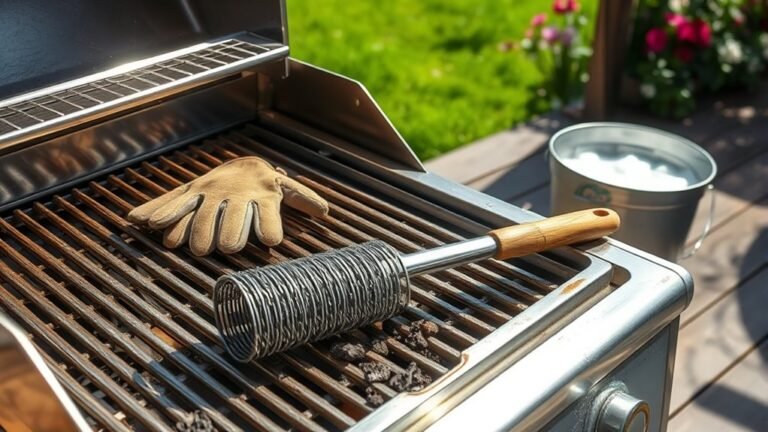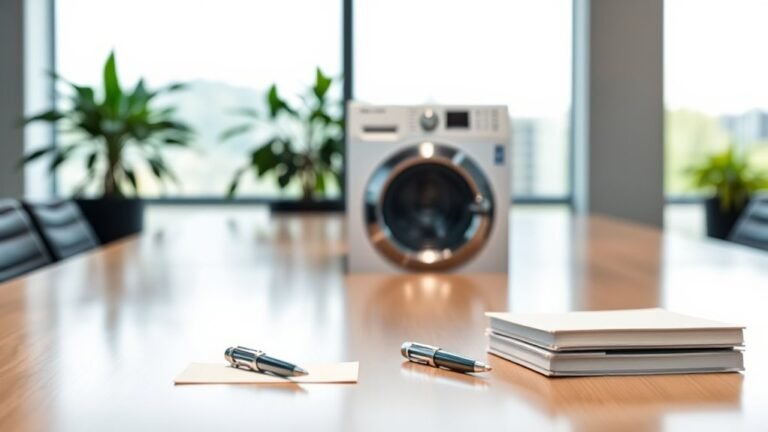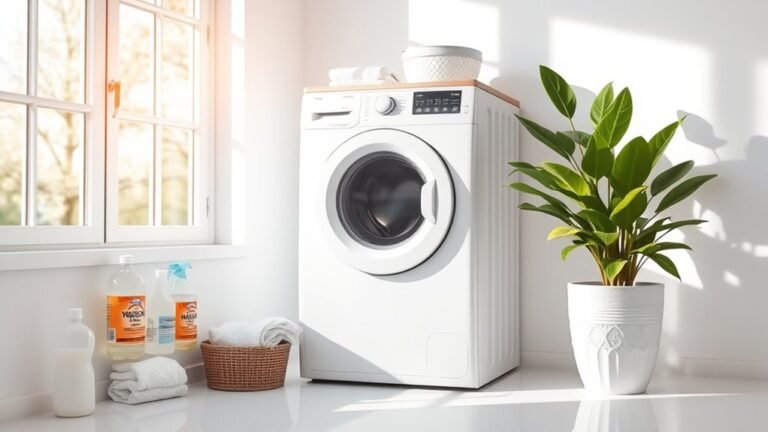How to Clean Range Hood
To clean your range hood, first confirm it’s powered off and cooled. Remove the filters carefully and soak them in hot water mixed with degreasing soap for 15–30 minutes. Clean the exterior with a suitable cleaner, wiping with the grain, and scrub interior parts like fan blades with a soft brush and mild detergent. Dry all parts thoroughly before reassembling to avoid damage. Regular upkeep like this improves efficiency and odor control—explore more detailed steps to keep your kitchen fresh and functional.
Preparing Your Range Hood for Cleaning

Before you begin cleaning your range hood, make sure it’s completely powered off to avoid any electrical hazards. Prioritize safety precautions by unplugging the unit or switching off the circuit breaker. Confirm the hood has cooled down to prevent burns. Establish a regular cleaning schedule based on your cooking frequency—monthly for heavy use, quarterly for moderate. This schedule helps maintain ideal airflow and efficiency. Next, gather necessary tools: gloves, a screwdriver, and non-abrasive cleaning agents. Remove any detachable parts only after ensuring the hood is off. Clear the surrounding area to access all surfaces easily. By preparing methodically, you reduce risks and streamline the cleaning process, ultimately extending your range hood’s lifespan and preserving your freedom from frequent repairs or replacements.
Removing and Soaking the Filters
Start by carefully detaching the filters using the specific removal mechanism your range hood employs, whether it’s a latch, clip, or simple pull-out design. Prepare a soaking solution with hot water and a degreasing agent like dish soap or baking soda to break down accumulated grease effectively. Let the filters soak for at least 15 to 30 minutes to guarantee thorough loosening of grime before scrubbing.
Filter Removal Techniques
To effectively remove and soak your range hood filters, you’ll need to locate the latch or tab that secures each filter in place. Depending on your filter types—mesh, baffle, or charcoal—the removal mechanisms vary slightly. Mesh and baffle filters usually have a simple push or pull tab, while charcoal filters might require unscrewing. Before detaching, verify the hood is off and cool. Gently press or slide the latch to release the filter without bending or damaging it. Once free, handle the filters carefully to avoid warping. These maintenance tips help preserve filter integrity and improve longevity. After removal, you’re ready to soak them properly. Following correct removal steps not only eases cleaning but also maintains ideal airflow and filtration performance.
Soaking Solutions Options
Once you’ve carefully removed the filters, the next step is selecting the appropriate soaking solution to break down grease and grime effectively. A vinegar solution—mixing equal parts white vinegar and hot water—works as a powerful degreaser and natural disinfectant. For tougher buildup, sprinkle baking soda over the filters before submerging them in the vinegar solution; this combination creates a mild abrasive action that loosens stubborn residues without damaging the metal. Use a container large enough to fully immerse the filters, ensuring all surfaces are exposed to the solution. Avoid harsh chemicals that may corrode or weaken filter materials. This approach empowers you to restore your range hood filters to peak performance, maintaining airflow efficiency and prolonging the life of your kitchen equipment with minimal environmental impact.
Soaking Duration Tips
How long should you soak your range hood filters to guarantee excellent cleaning? Generally, a soaking duration of 15 to 30 minutes is best. This timeframe allows the degreasing solution to penetrate and break down accumulated grease without damaging the filter’s material. If your filters are heavily soiled, extending the soak to 45 minutes can improve results, but avoid exceeding one hour to preserve filter effectiveness. After soaking, use a soft brush to dislodge stubborn residues before rinsing thoroughly. Keep in mind that soaking too briefly won’t remove all grease, reducing airflow and compromising filter performance. By adhering to these soaking duration tips, you maintain your range hood’s efficiency and extend filter lifespan, giving you the freedom to cook without worrying about buildup or ventilation issues.
Cleaning the Exterior Surface
You’ll want to select cleaning products compatible with your range hood’s material, such as stainless steel or painted surfaces, to avoid damage. Begin by applying a suitable cleaner and gently wiping in the direction of the grain to prevent scratches. Finish with a microfiber cloth to remove residue and restore shine effectively.
Choosing Cleaning Products
Although selecting the right cleaning products may seem straightforward, it’s crucial to contemplate the material of your range hood’s exterior to avoid damage. Stainless steel surfaces require non-abrasive, pH-neutral eco friendly cleaners that won’t strip the protective finish. For painted or coated metals, avoid harsh degreasing agents that could cause discoloration or peeling. Glass or ceramic surfaces benefit from mild, ammonia-free solutions to prevent clouding. When choosing degreasing agents, prioritize biodegradable formulas with natural solvents to effectively break down grease without compromising indoor air quality. Always test a small, inconspicuous area first to verify compatibility. By selecting tailored, eco friendly cleaners and degreasing agents suited to your hood’s material, you maintain its appearance and functionality while aligning with sustainable cleaning practices—giving you freedom from harsh chemicals and damage risk.
Step-by-Step Wiping Process
Selecting the right cleaning products sets the foundation for preserving your range hood’s surface during cleaning. Begin by choosing a soft microfiber cloth or a non-abrasive cotton cloth, as these cloth types prevent scratches and effectively trap grease. Dampen your cloth with a mild detergent solution, making certain it’s not overly saturated to avoid streaks. Employ circular wiping techniques to disrupt and lift grime without spreading it. Start at the top and work your way down, applying gentle but firm pressure. For stubborn spots, let the cleaner sit briefly before wiping. Always follow by drying with a clean, dry microfiber cloth to eliminate moisture and prevent watermarks. Consistent application of these wiping techniques guarantees a thorough clean while maintaining your range hood’s finish and functionality.
Scrubbing the Interior Components

Start by carefully removing the filter and any detachable parts from the range hood’s interior. For effective interior scrubbing, use a degreasing solution or a mixture of warm water and dish soap. Apply it with a soft-bristled brush or non-abrasive sponge to target grease buildup without damaging surfaces. Focus on accessible interior components like fan blades, motor housings, and vent openings, ensuring thorough component care. Avoid harsh scrubbing tools that can scratch or dent metal parts. For stubborn grime, let the solution sit briefly before scrubbing. Rinse parts with clean water to remove residue, preventing future grease accumulation. Maintaining these components preserves airflow efficiency and prolongs your range hood’s lifespan, giving you the freedom to cook without worrying about performance deterioration.
Drying and Reassembling the Range Hood
Once you’ve thoroughly cleaned and rinsed the interior components, the next step is to confirm they are completely dry before reassembling the range hood. Use efficient drying techniques like air drying in a warm, well-ventilated space or gently wiping with a microfiber cloth to prevent water spots and corrosion. Avoid using abrasive materials that could damage surfaces. When reassembling, follow reassembling tips such as aligning filters and panels precisely to avoid gaps that reduce performance. Secure screws and clips firmly but don’t overtighten, as this can strip threads or crack parts. Double-check electrical connections if applicable and test the fan and lights before completing the process. Proper drying and careful reassembly confirm your range hood functions at peak efficiency and extends its service life.
Tips for Regular Maintenance and Odor Control

Although thorough cleaning is essential, maintaining your range hood regularly is equally important to prevent buildup and control odors effectively. To minimize grease buildup, wipe down the exterior and accessible interior parts weekly with a degreasing cleaner. Replace or clean filters monthly, depending on your cooking frequency, to maintain peak odor absorption and airflow. Avoid using harsh chemicals that can damage components or reduce filter efficiency. Use activated charcoal or baking soda near the hood to enhance odor absorption naturally between deep cleanings. Check the vent and ductwork periodically for obstructions, ensuring proper ventilation and preventing stagnant air, which contributes to lingering smells. By integrating these practical maintenance steps, you’ll extend your range hood’s lifespan and enjoy a fresher kitchen environment without compromising your freedom to cook boldly.
Frequently Asked Questions
Can I Use a Dishwasher to Clean Range Hood Filters?
You can use a dishwasher to clean range hood filters, but you should check dishwasher safety first. Most metal mesh filters handle dishwasher cleaning well, saving you time and effort. However, avoid using harsh detergents or high heat cycles that might damage the filter’s coating. Regular dishwasher cleaning supports effective filter maintenance, ensuring peak airflow and grease removal. Always confirm your filter’s compatibility to maintain its longevity and performance freedom.
How Often Should I Replace My Range Hood Filters?
You know what they say: “A stitch in time saves nine.” When it comes to filter maintenance, replacing your range hood filters depends on filter types. Metal mesh filters can last up to a year with regular cleaning, but charcoal or carbon filters usually need replacement every 3 to 6 months. Keeping an eye on your filters guarantees peak air quality and system efficiency, giving you the freedom to cook without worry.
Are There Eco-Friendly Cleaning Products for Range Hoods?
Yes, you can definitely use eco-friendly cleaning products for your range hood. Natural cleaners like white vinegar, baking soda, and lemon juice work great as homemade solutions. These ingredients break down grease and grime effectively without harsh chemicals. Mix baking soda and water into a paste or combine vinegar and lemon juice for a powerful degreaser. This way, you maintain a clean hood while reducing environmental impact and keeping your kitchen toxin-free.
What Should I Do if My Range Hood Motor Is Noisy?
Coincidentally, a noisy range hood motor often signals it’s time for motor maintenance. You’ll want to first unplug the unit and remove the fan cover to inspect for debris or loose parts causing vibration. Lubricate the motor bearings with appropriate oil to guarantee smooth operation. Tighten any screws or mounts to reduce rattling. Regular noise reduction efforts not only extend motor life but also give you freedom from annoying sounds during cooking.
Can a Dirty Range Hood Affect Indoor Air Quality?
Yes, a dirty range hood can definitely impact indoor air quality. When grease and grime build up, the hood’s ability to filter air pollutants diminishes, allowing harmful particles to circulate. This can increase health risks, especially respiratory issues. To maintain a safe and breathable environment, you need to guarantee your range hood functions at its best by keeping it clean and free of blockages, so pollutants don’t compromise your indoor air quality.






